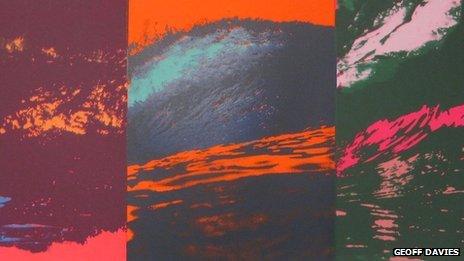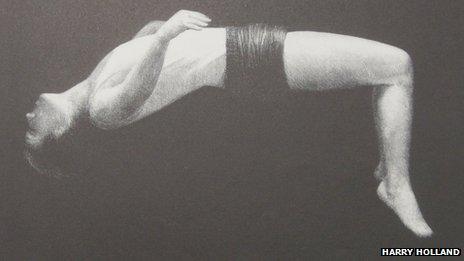Eisteddfod's 'lost' artwork goes on show in Cardiff
- Published

Commissioned with help from the Arts Council of Wales, the prints were to be sold to raise money for visual art prizes at the festival.
Eisteddfod artworks that have been "lost" for nearly 40 years are going back on show at an exhibition.
The Prints for the Proclamation portfolio was produced in 1977 by Cardiff artists to mark the festival being held in the city a year later.
Each of the 25 artists produced 35 original prints.
A three day exhibition of the screen-prints, lithographs and etchings is being held at BayArt gallery, Bute Street, from Tuesday.
The possibility of the collection still being in existence was first suggested by solicitor Neil Confrey who contacted the National Eisteddfod having bought two other prints in a Cardiff gallery in the mid-1990s.
It appears that some point during the 1980s unsold prints from an original exhibition to raise funds for the Cardiff event were in the care of the Welsh Arts Council and transferred to the National Eisteddfod.
After much rummaging, a large wooden box was found gathering dust in the Eisteddfod's Cardiff office. It contained various prints by the artists.
The idea of a new exhibition came last year from Mr Confrey who contacted the office.

The exhibition includes silk printing work, lithography and scripture
The prints on show will also be sold to raise funds towards the visual arts section of the Carmarthenshire 2014 National Eisteddfod.
Glyn Jones, who is behind Prints for the Proclamation said the original venture had two aims.
He said: "Firstly to try to raise cash to increase the prize money and so attract more artists to enter the Eisteddfod art competition.
"Secondly to introduce into the pre-festival publicity a marker which proclaimed that this Eisteddfod was going to reflect a broader contemporary art scene and hence attract more artists to exhibit."
Since producing the prints, two of the participants, Paul Brewer and Phil Nicol, went on to win the National Eisteddfod's gold medal for Fine Art.
Two others - Terry Setch and Chris Orr - are now members of the Royal Academy in London.
Writer Jo Mazelis who has an essay accompanying the prints in the exhibition said: "They were produced at an important time for the Eisteddfod, and for visual art in Wales, and they are an important record of that time, contradictory, diverse and evolutionary as it was. As it still is."

The original plan was to produce a limited number of 35 prints per artist
- Published23 November 2013
- Published24 October 2013
- Published9 August 2013